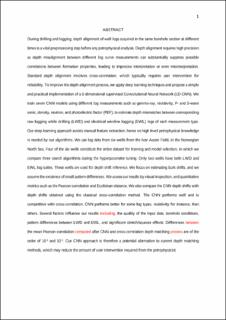| dc.description.abstract | During drilling and logging, depth alignment of well logs acquired in the same borehole section at different times is a vital preprocessing step before any petrophysical analysis. Depth alignment requires high precision as depth misalignment between different log curve measurements can substantially suppress possible correlations between formation properties, leading to imprecise interpretation or even misinterpretation. Standard depth alignment involves cross-correlation, which typically requires user intervention for reliability. To improve the depth alignment process, we apply deep learning techniques and propose a simple and practical implementation of a 1-dimensional supervised Convolutional Neural Network (1D CNN). We train seven CNN models using different log measurements such as gamma-ray, resistivity, P- and S-wave sonic, density, neutron, and photoelectric factor (PEF), to estimate depth mismatches between corresponding raw logging while drilling (LWD) and electrical wireline logging (EWL) logs of each measurement type. Our deep learning approach avoids manual feature extraction; hence no high level petrophysical knowledge is needed by our algorithms. We use log data from six wells from the Ivar Aasen Field, in the Norwegian North Sea. Four of the six wells constitute the entire dataset for training and model selection, in which we compare three search algorithms during the hyperparameter tuning. Only two wells have both LWD and EWL log suites. These wells are used for depth shift inference. We focus on estimating bulk shifts, and we assume the existence of small pattern differences. We assess our results by visual inspection, and quantitative metrics such as the Pearson correlation and Euclidean distance. We also compare the CNN depth shifts with depth shifts obtained using the classical cross-correlation method. The CNN performs well and is competitive with cross-correlation. CNN performs better for some log types, resistivity for instance, than others. Several factors influence our results including, the quality of the input data, borehole conditions, pattern differences between LWD and EWL, and significant stretch/squeeze effects. Differences between the mean Pearson correlation computed after CNN and cross-correlation depth matching process are of the order of 10-1 and 10-2. Our CNN approach is therefore a potential alternative to current depth matching methods, which may reduce the amount of user intervention required from the petrophysicist. | en_US |
